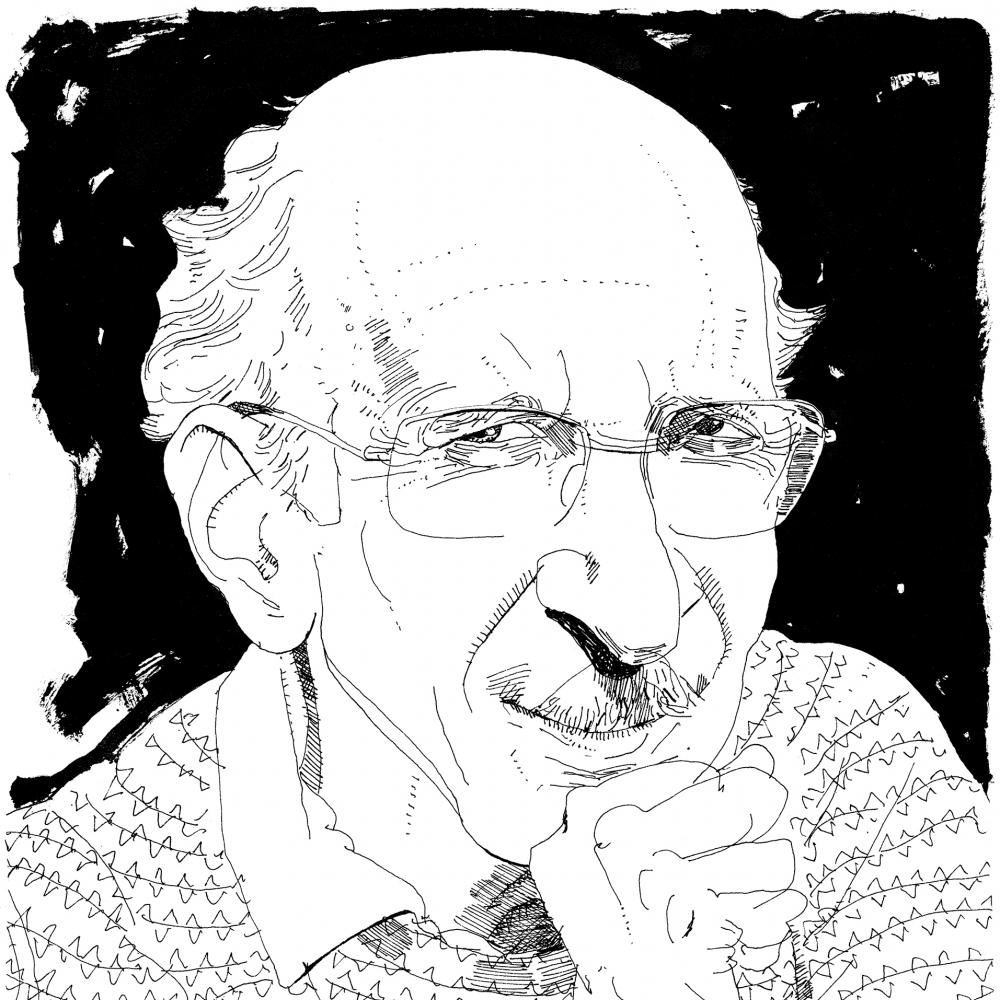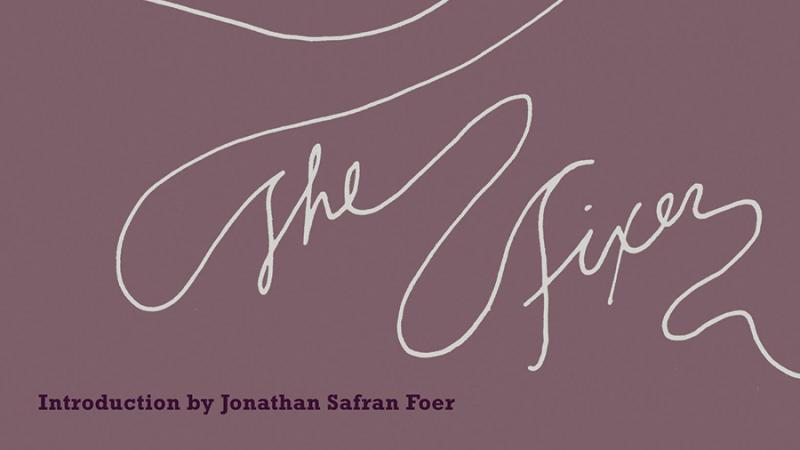“A small miracle has come to pass,” Bernard Malamud said in 1959, accepting the National Book Award for his short story collection The Magic Barrel. The miracle was that the short story was being so honored—the form, in many ways, Malamud was best at, but which, during awards season, tends to be neglected in favor of the novel. It was Malamud’s first moment in the spotlight, but the evening was a clumsy one. He forgot his $1,000 award check at the podium and, arriving late at the dinner in his honor, was told that there was no place for him to sit.
“Not for the first time I was seeing a Malamud story unfold,” the critic Alfred Kazin observed.
There’s a tendency, if not a formula, in Malamud’s fiction to invest humanity with a spiritual melancholy. Malamud protagonists are forever being held back, locked out, or stifled. Consider the graduate student whose efforts to research art in Rome are stymied by his inability to find a suitable apartment in “Behold the Key,” or the young man trapped in his room by his promise to consume a stack of books in “A Summer’s Reading,” or the ballplayer shot and disabled on the cusp of fame in The Natural, or the man exasperated by a faith healer’s evasions in “The Silver Crown.”
The conclusions of Malamud stories are often spiritual but rarely redemptive. They remind us of life’s strangeness and the inexplicability of God’s will. The arrival of a talking black bird in “The Jewbird” conveys both a sense of wonderment and a caution that reality is about to come crashing down.
“That’s how it goes,” he writes early in the story. “It’s open, you’re in. Closed, you’re out and that’s your fate.”
Who writes stories like this anymore? Who aspires to? In the fifties and sixties, Malamud’s talent for giving workaday sufferings and shortcomings the cast of a fable made him the quintessential postwar American writer; his work was a reminder that the degradations of the past, particularly for Jews, were not long past. For this, Malamud received the Pulitzer Prize, the National Book Award (twice), and was installed in a triumvirate with Saul Bellow and Philip Roth, what Bellow called the Hart, Schaffner, and Marx of literature.
Today, one hundred years after his birth, Malamud’s name endures in the Pen/Malamud Award, given annually to a distinguished short story collection, and now the Library of America has brought out a second volume of his novels and stories covering the 1960s. Still, his reputation lacks the towering height of Roth’s or Bellow’s. In truth, he was always an uneasy fit with those two. Bellow and Roth sought to balance their Jewish backgrounds with a commitment to the larger American scene. Malamud, to the contrary, stuck with Yiddish folklore and continued to bear witness to its strange magic. Imitators of that strategy will inevitably be rare, but it gives him a unique standing in American letters. To read him now is to experience something that feels new, in large part because its inspirations come from the very bedrock of all storytelling.
As innovators go, Malamud’s life was interior and modest. He all but hermetically sealed himself off from the outside world to dedicate his life to writing. He was born in New York in 1914 to immigrants from a Jewish shtetl in Ukraine. His father, Max, worked for a series of struggling groceries, an experience that provided Malamud with a model for his early fictions, particularly the foundering shop in his second novel, The Assistant (1957). His mother, Bertha, died in a mental hospital when he was fifteen.
He never aspired to be anything besides a writer: “At eight or nine I was writing little stories in school,” he told an interviewer in 1975. But, during the thirties and forties, literature vied with domestic responsibilities for priority in Malamud’s life. Raising a family forced him to take teaching gigs, and his failure to land an East Coast professorship sent him west, to the relatively undistinguished Oregon State College. There he labored over a novel, The Light Sleeper, that was roundly rejected by publishers. “I knew little about novel construction,” he later said, “and . . . less about the man I was writing about.” There’s no trace of the book now; he burned the manuscript pages in his backyard.
Malamud’s fortunes turned with the publication of his first novel, The Natural (1952), which had the support of the legendary editor Robert Giroux. It set the template for his storytelling, blending psychological realism and mythology, which alternately captivated and alienated readers and critics; few major American novelists’ careers have been so pockmarked with mixed reviews.
Unlike much of his cohort, Malamud was reluctant to discuss his work, or to weigh in more generally on the affairs of the day. Only late in his career, in 1971, with The Tenants, did he engage with contemporary race relations; his deepest exploration of anti-Semitism, his 1966 novel, The Fixer, was inspired by events in prerevolutionary Russia.
“I wanted the historical tie-up so I could invent it into a myth,” he wrote in an essay about the book. Eschewing relevance, Malamud emphasized work, letting the modern world dissolve as he wrote, rewrote—and rewrote the rewrites. In this regard he resembled E. I. Lonoff, the novelist at the center of Roth’s 1979 novel, The Ghost Writer. “I turn sentences around,” Lonoff says. “I write a sentence and then I turn it round. Then I look at it and turn it around again.”
“He’s not often brought up in conversation, but unlike Bellow or Roth, he never started many conversations about himself,” says critic Alan Cheuse, coeditor of Talking Horse, a collection of Malamud’s notes, commentaries, and essays on fiction. “He was just a different kind of person.”
Cheuse, who befriended Malamud in 1970 when they were both at Bennington College in Vermont, recalls him as an unusually focused and fastidious writer. “It was an astonishing method,” Cheuse says in a phone interview. “He would write what he’d call a draft of, say, ‘The Jewbird,’ and he would type it up. He would make corrections and changes to that typescript—that’s what he would call his first draft. He would then copy over the typescript in longhand to make the beginning of the second draft, and then type that up and make changes and so forth. Some stories went four drafts, some stories went twelve drafts, but he did both the longhand and the typescript for everything.”
Malamud’s head-down focus on work didn’t diminish his standing during his lifetime—it did, after all, allow him to produce the books and stories. But it did little to elevate his standing. When Bellow won the Nobel Prize in Literature in 1976, Malamud scribbled in his notebook: “Bellow gets Nobel Prize, I win $24.25 in poker.” The most likely culprit for Malamud’s relative lack of esteem with readers today, however, is the sui generis nature of his stories, a canny blend of religiosity and realism.
One contemporary writer whose work bears the clear influence of Malamud is Steve Stern, who since 1983 has been publishing novels and stories that mix folklore and realism in a Memphis Jewish enclave called the Pinch. The “extraordinary dimension” of Malamud’s work, Stern says, made him a kind of heir to America’s earliest fiction writers.
“Sometimes I think that he, in a way, is a kind of quintessentially American writer despite the Yiddish influences,” Stern says. “You can go back to somebody like Hawthorne, who was writing so-called romances—they’re tales, with recognizable settings and characters that have a credible psychology, but at the same time there’s a way in which the stories are open to the intrusion of the extraordinary. It’s something that I haven’t seen much of in American fiction since the beginning, with progenitors like Hawthorne and Poe.”
To put it another way: What Malamud wrote about was magic. Not in the sense of magical realism or the postmodern absurdities that marked much of the fiction that arrived with the next generation. Rather it was magic as an acknowledgment of an abiding religious presence. The Fixer tracks the years-long agony of a Russian Jew wrongly imprisoned for murder. As a study of persistent anti-Semitism, it’s harrowing and racked with sorrow, yet Malamud finds a way to clear room for the possibility of grace.
As the novel’s long-suffering fixer, Yakov, puts it, “If you understand that a man’s mind is part of God, then you understand it as well as I. In that way you’re free, if you’re in the mind of God…. It’s as though a man flies over his own head on the wings of reason, or some such thing. You join the universe and forget your worries.” Malamud was careful not to give this moment too much sentiment. A Russian official then asks, “Do you believe that one can be free that way?” But all Yakov says is, “Up to a point.”
Yakov is not rescued from the indignities of prison or a final unfair punishment. But for Malamud it was essential to acknowledge the division between an authentically spiritual existence and a real one that was thick with false charges and other deceptions. “Behind the world lies another world,” Yakov says, even as he laments that his integrity offers little balm against mistreatment in this world.
Invoking the spiritual was Malamud’s preferred strategy for highlighting man’s foibles. In “The Jewbird,” the strange speaking bird becomes a litmus test for a man’s anti-Semitism. The bird’s pleas for respect and shelter are more and more violently rebuffed by the head of a family, who thrusts the creature out of the home; in the process, Malamud exposes how readily frustration and anger expose prejudice. In “The Silver Crown,” a man’s willingness to trust a rabbi proffering the healing headpiece unlocks questions of how much the man loves God. The theme of tested faith persisted in Malamud’s fiction to the end of his life. In his final novel, God’s Grace (1982), he spun a postapocalyptic tale about the last human survivor of a global nuclear war, and this man’s attempt to create a new society among the primates on a remote island. Are his modest successes proof of God’s generosity, or was the larger cataclysm proof of His contempt? The question was a riddle with no answer, but for Malamud it demanded to be asked.
The poet Howard Nemerov, a friend of Malamud, said he deserved the Nobel Prize for God’s Grace alone. But the critical confusion that Malamud experienced with his first novel became part of his final one as well. The critic John Leonard, who is well-known for his harsh judgments, wrote in the New York Times that God’s Grace “groans under the weight of its many meanings, as if it were a rehearsal of the speech Mr. Malamud intends to make in Stockholm on being Nobel prized.” Again, Malamud seemed too enmeshed in his philosophizing to be relevant to the contemporary scene.
His death from a heart attack in 1986 did little to soften the blows. In 1974, Philip Roth wrote an essay called “Imagining Jews” for the New York Review of Books in which he critiqued what he perceived as tired Jewish stereotypes in works like The Assistant. A few months after Malamud’s death, he wrote a remembrance for the New York Times describing a dour final meeting with Malamud; the celebrated author, who had suffered a stroke in 1982, was reduced to working on incoherent scraps of writing. Even Roth’s lavish praise for Malamud in his heyday seemed to characterize him as a literary moment that passed: “[H]e remained true to what seemed old and homely, matter-of-factly emitting the most touchingly unadorned poetry to make things even sadder than they already were,” Roth wrote.
When Malamud emerged from his stroke in 1982, he identified himself as William, the protagonist of his 1979 novel, Dubin’s Lives. This anecdote highlights just how much the man and his work were woven together, perhaps even to an unhealthy degree. Major authors—even such hermits as Pynchon and DeLillo—are supposed to be part of the real world all of us live in, not the ones they have imagined. For Malamud, the Jewish grocery of his youth, the brutal landscape of the premodern Russian Pale, a small island on a planet blasted to bits—all of this was out of this world, and it was enough. “His entire sense of the world was powerfully antithetical to the cultural ethos of the times,” the critic Cheryl Miller wrote in Commentary.
Let’s be clear, though: Malamud hasn’t disappeared. All of his books remain in print, and writers like Cheuse and Stern continue to teach them. So does Joyce Carol Oates, who is a particular fan of his 1968 story “My Son the Murderer,” which she selected for The Oxford Book of American Short Stories. The story, which smoothly alternates between the perspectives of a wayward college graduate and his anxious father, is “a brilliant story of the 1960s division between the generations,” she says by email. “Though it is thoroughly of its time and place, contemporary young people sympathize with it immediately. The style, the language, the structure—all are masterful. That there is a ‘shared’ narrative voice to suggest the father-son dilemma makes the story especially powerful.”
You can detect trace elements of Malamud’s sensibility across contemporary American literature: in Steven Millhauser’s more folkloric stories, such as “Flying Carpets,” or in Jonathan Safran Foer and Nathan Englander’s visions of New York Jews, or even a novel like Michael Chabon’s The Amazing Adventures of Kavalier & Clay, where real life and superherodom stand cheek by jowl. Wherever the lower-middle class scrapes by while faith abides, there’s Malamud. Yet unlike many of his heirs, he always emphasized the scraping.
The ending of The Natural finds the mythic slugger collapsing under pressure, striking out and disgraced. The hit 1984 film version of the movie, starring Robert Redford, bowdlerized the story into a tale of easy uplift. The movie deliberately avoided what Malamud always knew to be true: Failure and cruel fate are as much a part of mythology as success.
Stern suggests that, lacking a splashy style, Malamud’s sensibility may simply demand too much of readers. Consider, for instance, the way “The Silver Crown” complicates the son’s emotional connection to his father with a test of faith he didn’t ask for. “You’ve got on the one hand what seems to be the necessary emotional condition for redemption of this character, and on the other hand this impossible miraculous component,” he says. “Malamud can reconcile these two things in a story. But it might be harder for a contemporary reader to connect. You really do have to suspend disbelief in the way that you do with a folk tale or a fairy tale. I think there’s a resistance to that.”
Malamud’s fiction suggested that it’s through stories that we can confront difficulty in ourselves. In “A Summer’s Reading,” a high school dropout tells a neighbor that he is about to read one hundred books, then allows a lie to circulate that he’s actually consumed them. Guilt stalks him: When he walks onto the street he is “a shadow of himself.” The story ends with the young man literally running to a library and sitting down to read—literature becoming as much a moral life buoy as a way to gain knowledge.
Art tends to be moral, Malamud once said, specifically in its awareness of “the sheer privilege of being, in this miraculous cosmos, and trying to figure out why. Art, in essence, celebrates life and gives us our measure.” No art could truly be art without a sense of the cosmic. That urge to explain the ineffable may account for why he was so dedicated to rewriting his sentences. As Cheuse points out, the revisions didn’t stop once a work was published. “He’d clip out the pages from the magazine, make changes in the published pages and when it was part of a story collection, he’d get proofs and make changes there, then changes in the second proofs.
“Then it would come out in book form, and he would make changes in the book,” he adds. “He’s probably still doing that somewhere.”






